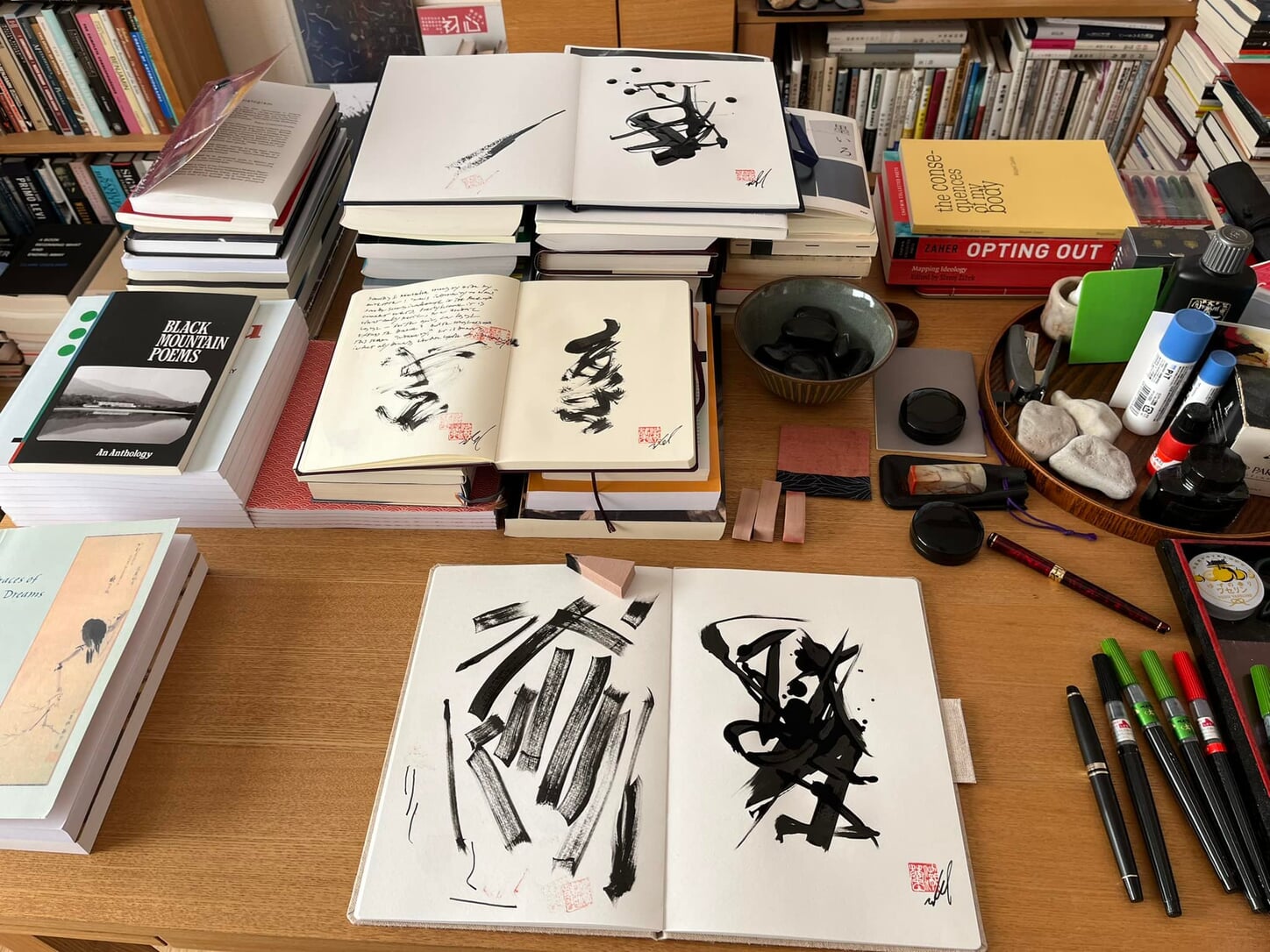TW Creatives: Eric Selland’s Asemic Calligraphy
Tokyo Weekender’s sequence TW Creatives options varied works by Japan-based writers, photographers, videographers, illustrators and different creatives in a bid to offer one further platform for them to exhibit their expertise. The works submitted right here belong completely to the creators. TW solely takes pleasure in being one in every of their most passionate supporters. This time, we introduce the calligraphy of poet and translator Eric Selland.
Calligraphy is a artistic romance the place writing and portray come to satisfy. Within the calligraphy notebooks of poet Eric Selland that story occurs in a brand new recent means. Ink pen and ink brush play the primary roles. The previous is for writing ideas, quotes, philosophy and journal entries, whereas the latter is for the ink work of asemic kanji characters. They share the house and intertwine, but additionally deconstruct calligraphy and play with the absence of that means behind the kanji-like characters.

The Beginnings
Selland’s foray into calligraphy and portray has been slowly unfolding for years. He grew up with Japanese and Chinese language artwork round him. Then, he was educated in calligraphy in school when he studied Japanese language and tradition.
“I feel it simply got here naturally once I started to seek out the necessity to make my work in poetry extra bodily or concrete, shifting from the extra frequent poet’s pocket book into one thing extra like pocket book artwork,” Selland says.
Chinese language characters are inherently visible, combining artwork and writing in each single phrase. Selland has additionally all the time been serious about visible or concrete poetry and the visible nature of language.
“Calligraphy is a solution to be visible, to color, and but on the similar time to retain a relationship to the phrase and to writing. And it represents that time the place the language steadily turns into summary,” he says.
The Poetry within the Course of
Selland’s calligraphy work flows from web page to web page, from pocket book to pocket book, intertwined with journaling. Though most of his ink work may be singled out from the pocket book, the poet maintains that they’re fragments of a course of and the notebooks as a complete are the ever-evolving art work. That’s the reason he has, so far, abstained from naming any facet of this poetry-art challenge.
“Within the context of the pocket book, the brushwork is a part of the poetic course of. It is not one thing separate from writing or poetry, however since it isn’t as intellectualized because the writing that it seems apart it permits for one thing extra spontaneous and expressive on a degree that transcends language as we normally perceive it. In among the works I sense nearly a sort of violence — there is a want to interrupt out of the restrictions that may be set by language and varied facets of life. The work permit me to sort of “explode” and let all of it out. In among the pictures, I embrace my handwriting in English with the calligraphy in order that the 2 merge with or develop out of each other,” the poet explains.
Artwork, Jazz and Freedom
On the similar time, he shares that it is all about listening to what the paper, the comb and the ink need. There’s a sure resistance if the artist tries to pressure a preconceived imaginative and prescient. Just like a meditative apply or jazz improvisations, it is all about being current and versatile within the means of creation. If ink begins working out, he’ll use that as a device, portray with the very absence of ink, relishing within the strokes that depart calligraphy deconstructed.
Selland shares that he’s actually impressed by jazz in addition to summary artwork.
“I am fascinated with the artwork of the Nineteen Fifties when Japanese calligraphers started to do summary portray primarily based on calligraphy and among the main summary expressionist painters in New York started to do black work with apparent influences from Japanese calligraphy,” Selland says.
Apart from the asemic calligraphy notebooks, Selland has additionally been doing particular person summary work, experimenting with extra colours. He is planning to exhibit his work and is searching for a gallery to signify him.
Selland can be within the early phases of getting ready a e book of his calligraphy notebooks for publication.
You possibly can see extra of his work and phone him by way of Fb.
Eric Selland has been translating modernist and up to date Japanese poets for practically 40 years. He has revealed six books of his personal poetry, together with Arc Tangent and Beethoven’s Dream, each on Isobar Press. Eric’s translation of The Visitor Cata novel by Takashi Hiraide, was on the New York Occasions Bestseller record in February of 2014 and his translation of poems by Kiwao Nomura, The Day Laid Naked, was chosen as a really useful translation by The Poetry Guide Society, UK. His most not too long ago revealed poetry translation is Kusudama, by Minoru Yoshioka (Isobar Press, 2021). He’s a co-editor with Sawako Nakayasu on the New Instructions Anthology of twentieth Century Japanese Poetry anticipated to grow to be accessible in 2024.
